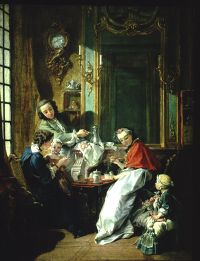Encyclopedia, Difference between revisions of "Francois Boucher" - New World
David Doose (talk | contribs) m |
({{Contracted}}) |
||
| Line 1: | Line 1: | ||
| + | {{Contracted}} | ||
{{epname}} | {{epname}} | ||
[[Image:Boucher par Gustav Lundberg 1741.jpg|thumb|right|200px|François Boucher]] | [[Image:Boucher par Gustav Lundberg 1741.jpg|thumb|right|200px|François Boucher]] | ||
Revision as of 15:23, 11 June 2007
- For other uses, see Boucher (disambiguation)
François Boucher (September 29 1703 – May 30 1770) was a French painter, a proponent of Rococo taste, known for his idyllic and voluptuous paintings on classical themes, decorative allegories representing the arts or pastoral occupations, and intended as a sort of two-dimensional furniture. He also painted several portraits of his illustrious patroness, Madame de Pompadour.
Biography
Born in Paris, a the son of decorator Nicolas Boucher, François Boucher was perhaps the most celebrated decorative artist of the 18th century, with most of his work reflecting the Rococo style. At the young age of 17, Boucher was apprenticed by his father to François Lemoyne, however after only 3 months he went to work for the engraver Jean-François Cars. Within 3 years Boucher had already won the elite Grand Prix de Rome, although he did not take up the consequential opportunity to study in Italy until 4 years later. On his return from studying in Italy in 1731, he was admitted to the Royal Academy of Painting and Sculpture as a historical painter, and became a faculty member in 1734.
His career accelerated from this point, as he advanced from professor to Rector of the Academy, becoming head of the Royal Gobelin factory in 1755 and finally Premier Peintre du Roi (First Painter of the King) in 1765.
Reflecting inspiration gained from the artists Watteau and Rubens, Boucher's early work celebrates the idyllic and tranquil, portraying nature and landscape with great élan. However, his art typically forgoes traditional rural innocence to portray scenes with a definitive style of eroticism, and his mythological scenes are passionate and amorous rather than traditionally epic. Marquise de Pompadour (mistress of King Louis XV), whose name became synonymous with Rococo art, was a great fan of Boucher's, and it is particularly in his portraits of her that this style is clearly exemplified.
Paintings such as The Breakfast of 1739, a family scene, also show Boucher as a master of the genre scene, as he regularly used his own wife and family as models. These intimate family scenes are, however, in contrast to the 'licentious' style, as seen in his Odalisque portraits. The dark-haired version of the Odalisque portraits prompted claims by Diderot that Boucher was "prostituting his own wife," and the Blonde Odalisque was a portrait that illustrated the extra-marital relationships of the King. Boucher gained lasting notoriety through such private commissions for wealthy collectors and, after the ever-moral Diderot expressed his disapproval, his reputation came under increasing critical attack during the last of his creative years.
Along with his painting, Boucher also designed theatre costumes and sets, and the ardent intrigues of the comic operas of Favart (1710-1792) closely parallel his own style of painting. Tapestry design was also an interest and major activity of his, together with his design activities for the opera and the royal palaces of Versailles, Fontainebleau and Choisy. His designs for all of the aforementioned augmented his earlier reputation, resulting in many engravings from his work and even reproduction of his themes onto porcelain and biscuit-ware at the Vincennes and Sèvres factories.
Francois Boucher died on May 30 1770 in Paris, France. His name, along with that of his patron Madame de Pompadour, had become synonymous with the French Rococo style, leading the Goncourt brothers to write: "Boucher is one of those men who represent the taste of a century, who express, personify and embody it."
Works include
- Web Gallery of Art
- Rinaldo and Armida (Louvre Museum)
- The Rest on the Flight to Egypt
- Diana Leaving her Bath
- Portrait of Marie-Louise O'Murphy (Alte Pinakothek)
- Autumn
- Putti with Birds (L'Amour Oiseleur), ca. 1731-33 Honolulu Academy of Arts
- The Visit of Venus to Vulcan
- Christ and John the Baptist as Children
- Pastorale
- Naiads and Triton
- Triumph of Venus
- Venus Consoling Love
See also
- History of painting
- Western painting
Credits
New World Encyclopedia writers and editors rewrote and completed the Wikipedia article in accordance with New World Encyclopedia standards. This article abides by terms of the Creative Commons CC-by-sa 3.0 License (CC-by-sa), which may be used and disseminated with proper attribution. Credit is due under the terms of this license that can reference both the New World Encyclopedia contributors and the selfless volunteer contributors of the Wikimedia Foundation. To cite this article click here for a list of acceptable citing formats.The history of earlier contributions by wikipedians is accessible to researchers here:
The history of this article since it was imported to New World Encyclopedia:
Note: Some restrictions may apply to use of individual images which are separately licensed.




